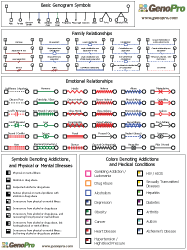

The use of social relationships links allows the genogram to be used in a business environment to create organizational charts or floor plan layouts of the employees.Ī genogram looks like a family tree, but with all the different types of relationships, it contains a significantly more detailed and complete picture of the family or group it illustrates. Social relationships can also illustrate an individual’s relation to a social entity like Andrew and the boarding school in Figure 2. These allow users to link individuals who are not related to one another, but who have a connection in society-at-large, such as neighbor, co-worker, boss-employee, pastor-church member, teacher-student, etc. Figure 4 illustrates the symbols commonly used for emotional relationshipsĪnother component of genograms is social relationships. In Figure 2, the double dotted line between Lily and Natalie illustrates discord, the line with red stripes illustrates distrust between Paul and his son Andrew, and the broken line between Lily and Frank illustrates a cut-off relationship. Colour-coded lines represent various emotional relationships that bond individuals together. These provide an in-depth analysis of how individuals relate to one another. Genograms usually also include emotional relationships. Figure 3 illustrates the symbols commonly used for family relationships. Within family relationships, you can illustrate if a couple is married, divorced, common-law, engaged, etc.

One of the advantages of a genogram is the ability to use colour-coded lines to define different types of relationships such as family relationships, emotional relationships and social relationships.

For example, a genogram will not only tell you that your uncle Paul and his wife Lily have three children, but that their eldest child was sent to boarding school, that their middle child is always in conflict with her mother, that their youngest has juvenile diabetes, that Uncle Paul suffered from depression, was an alcoholic, and a philosopher, while Aunt Lily has not spoken to her brother for years, has breast cancer and has a history of quitting her jobs. It will not only show you the names of people who belong to your family lineage, but how these relatives relate to each other. The inside of the symbol will hold the person’s current age or various codes for genetic diseases or user-defined properties: abortions, still-births, SIDS, cohabitations, etc.Ī genogram can contain a wealth of information on the families represented. Genogram symbols will usually have the date of birth (and date of death if applicable) above, and the name of the individual underneath. There are also computer programs that are custom designed for genograms. Genograms can be prepared by using a complex word processor, or a computer drawing program. Some genogram users also put circles around members who live in the same living spaces. Figure 1 illustrates basic genogram symbols with various types of individuals. Few if any genealogists yet use them.Ī genogram is created with simple symbols representing the gender, with various lines to illustrate family relationships. Some practitioners in personal and family therapy use genograms for personal records and/ or to explain family dynamics to the client. Genograms are now used by various groups of people in a variety of fields such as genealogy, medicine, psychiatry, psychology, social work, genetic research, education, and many more. Genograms were first developed and popularized in clinical settings by Monica McGoldrick and Randy Gerson through the publication of a book titled Genograms: Assessment and Intervention in 1985. It can be used to identify repetitive patterns of behavior and to recognize hereditary tendencies. It goes beyond a traditional family tree by allowing the user to visualize hereditary patterns and psychological factors that punctuate relationships. A genogram is a pictorial display of a patient's family relationships and medical history.


 0 kommentar(er)
0 kommentar(er)
